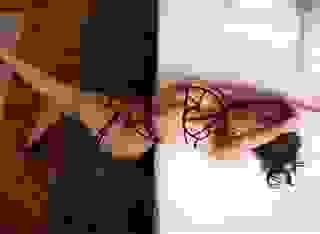Note: You can change font size, font face, and turn on dark mode by clicking the "A" icon tab in the Story Info Box.
You can temporarily switch back to a Classic Literotica® experience during our ongoing public Beta testing. Please consider leaving feedback on issues you experience or suggest improvements.
Click hereThe opening remarks of District Attorney Jeff Bagdon were the first item of significance, and he got right to the point. "Members of the jury, I'm going to be up front with you. We don't have the body of the victim in this case, Mark Evans. However, we do intend to show you that he is deceased, and that the two accused are, without doubt, guilty of his murder."
He began slowly, stating that the two accused had begun an affair several months before the murder. At some point Mark Evans had become aware of the situation, and had commenced an action for divorce from his unfaithful wife. Some things were unknown, such as how and when exactly Mark Evans had become suspicious. He described how a trail discovered on Mark Evans computer would prove that he knew when and where the two adulterers had met. There would be emails that documented his progress at tracking the two accused, arranging his finances in anticipation of his divorce, and finally, a message that demonstrated his intention to confront the two accused.
He continued, "We can't demonstrate precisely when the three parties to this triangle physically got together, but we know what the results were, and we can show you with pictures and investigative reports exactly what took place. We believe that an encounter occurred between the three of them, likely at the residence of Mr. Moore, and in that encounter Mr. Evans was incapacitated. He was then driven, seated in the passenger seat and probably unconscious, to a remote area of George Washington Park, less than half a mile from Mr. Moore's home."
"Once at the park, one of our two accused shot Mr. Evans in the upper right chest. We don't know whether Mr. Evans was conscious at the time of the shooting, but he was still seated in the passenger seat. The evidence shows that he was dragged from the seat and thrown to the ground, coming to rest against one of several pieces of firewood scattered around the picnic site. He was shot again, as he lay on the ground. Evidence will show that this bullet nicked his carotid artery, and you'll see graphic photographs of the blood evidence of the last moments of his life."
At this point Lisa Evans lost her composure, and only after several warnings from Judge Cox was her lawyer finally able to get his client under control so that the district attorney could continue with his opening statement.
"The circumstances are horrific, as even the reaction of the defendant suggests." He paused for effect before continuing, "After being shot a second time, Mr. Evans was rolled into a plastic shroud, dragged from the picnic site, and loaded unceremoniously into the trunk of Mr. Moore's car. He was taken someplace unknown to us, and buried."
"Mr. Moore took the murder weapon, along with the shovels used to create Mr. Evans' grave, and dumped them into the river. We are fortunate that a concerned citizen saw this act take place and reported it, through Crimestoppers. The police were able to recover the murder weapon, and the instruments of Mr. Evans' disposal."
"Through sound investigative techniques, and precise forensic testing, it can be proven that both of the accused were at the scene of the crime. Blood from the deceased has been identified on the exterior of Mr. Moore's car, transferred when the unfortunate Mr. Evans was loaded into the trunk. Lisa Evans can be placed at the scene as well. Her husband's blood was detected in her car, and on the shoes she wore that day."
"The defense will say that the two adulterers were nowhere near the scene of this horrific crime. How can they prove this? Why, with their own testimony of course. Each will make the claim that the other was with them at the time of the murder, and could therefore not be involved. This self-interested testimony will not, I'm sure, divert you the jury from finding them guilty."
It was a difficult statement for Basil Smith to speak against. He tried, emphasizing that the defendants were innocent until proven guilty, and that such proof was not going to be available in such a circumstantial case. He asked that the jury disregard the DA's opening statement, and instead rely upon the evidence that they would be shown in court. It was a brave attempt, but several veteran court reporters from the local newspapers gave round one to the District Attorney.
The first witness was the departmental computer expert, who described finding the emails and the maps illustrating the route taken by Mrs. Evans on the occasions that she met illicitly with Mr. Moore. The method that Mark Evans had used had been described in one of his emails to his lawyer, and the computer expert went on to explain to the jurors how a little electronic device was able to precisely track the defendant's car, and then allow her husband to re-create on his computer a precise map with time and locations that told him precisely where and when she met her lover.
One of the reporters took careful notes, and planned to include the name of Rocky Mountain Tracking in his story. He was confident that more than one husband or wife would be checking out the Company's product based on the successful use that it had been put to by Mr. Evans.
During this testimony Blake Moore seemed slightly bored, while Lisa Evans appeared very embarrassed, and wouldn't look at the jurors. There was really nothing that could be gained by Basil Smith in cross-examining this witness. The tracking device was what it was, and the emails he knew, could be quickly verified by his own law partner, Robert Graham.
After breaking for a lengthy lunch, the trial resumed in the afternoon with testimony from the 911 operator and the two patrol officers who had answered the initial call. They were simply determining the basic facts surrounding the discovery of Mark Evans' car, and the testimony was relatively without drama.
That changed once the detectives, involved with attending the scene after the state of the site was reported by the patrol officers, began their testimony. The description of the site as it had been given by the district attorney was now being testified to by the forensic technicians and medical examiner who attended the scene. Their descriptions were clinical and precise, illustrated with large photos that showed the bullet holes, the blood and the drag marks leading to the paved roadway.
The medical examiner testified to the quantity of blood that he felt was distributed around the scene. There was no way to physically measure its volume as much had soaked into the sand and upholstery, but he estimated that it represented 3 to 4 pints, a good percentage of the roughly 10 pints in a human body. His most effective testimony, though, concerned the four distinct sprays of blood that extended from the area of the bullet hole in the blood soaked block of firewood.
He testified that they indicated that a main artery had been cut, and the force provided by the victim's heart was propelling the blood in a spray away from the body. He showed how each of the four separate sprays was of a decreasing length, which indicated that the heart was losing its ability to pump blood. It was when he said that it proved the victim was in the act of dying that Lisa Evans lost control of her emotions again.
She screamed, "No! Mark can't be dead!" Lisa broke into uncontrollable tears, and when it became obvious that she was not going to be able to control her emotions for some time, the judge called an end to the proceedings. Court was adjourned until 10 a.m. the next day.
The second day of the trial began just as the first one had, right at 10 AM. The medical examiner once again took the witness stand, but little additional information was given. Primarily he expanded on the tests that had been done on the blood samples that had been taken. Within 15 minutes the prosecutor, District Attorney Jeff Bagdon, had finished his questioning and the witness was turned over to the defense attorney.
As Defense Attorney Basil Smith got up from his seat and took a few steps towards the witness, he glanced back quickly to confirm that his client, Lisa Evans, was in control of her emotions and not about to disturb the court again, as she had the afternoon before. He knew that she had been prescribed something to calm her down, but he was still afraid that she might interfere with his cross-examination of the witness. He was happy to note that for now she seemed to be sitting calmly in her seat.
He knew he was going to have to discredit some of the medical examiner's testimony from the day before, as it was quite graphic and left a strong impression that the shooting in the park had been quite heartless, almost an execution. He began, "You stated that Mark Evans lost three to four pints of blood in the park. At the same time, you stated that it was impossible to know for certain, because of the conditions, and that it was simply your estimate. Isn't it possible that the blood loss could have been as low as one to 2 pints, depending on how the blood was distributed around the site?"
The medical examiner, known to be a conscientious professional, thought for a few moments before saying, "It isn't likely, but it isn't impossible."
Basil Smith remained quiet for almost a minute, letting the medical examiner's acknowledgment sink in with the jury. He then continued, "What you described as a fatal wound to Mark Evans could have been less than fatal if someone were to have applied immediate first aid, wouldn't you agree?"
Again, the medical examiner thought before answering, "My answer is the same as to your last question. It isn't likely, but it isn't impossible. Medical attention would likely have been needed within minutes of receiving a wound of that nature. There is no evidence of that occurring."
The defense attorney quickly said, "There is no evidence of assistance being offered, but as you say, it is possible." He dismissed the witness, happy to have gained a couple of small concessions from him.
The next witness was one of the forensics technicians whose specialty was guns and ammunition. He testified about the recovery of the two slugs, one from the seat and one from a block of firewood. He testified that the ammunition was of the type known as Full Metal Jacket, and that it was frequently used for target shooting, and was the standard for military applications. The slug recovered from the car had hit a metal seat support and had been severely deformed, but the second one, recovered from the firewood, had been in very good condition. Matching it to the weapon pulled from the river had been very easy to do.
Basil Smith had done his homework with regards to ballistics and the science of how bullets reacted with human bodies. He asked, "Were the bullets examined for any residue of the bone or flesh that they had passed through before recovery?" He knew that this kind of testing could possibly even identify which organs of the body a bullet had penetrated.
The technician confirmed that such tests had been done, and continued, "We found very little on the actual bullets, beyond traces of blood. The bullet that was fired into the car seat passed through about 2 inches of various layers of padding and fabric. We think that may have stripped it clean. A similar situation exists with the second bullet, the one that became lodged in the firewood."
"The bullets themselves were commonly used by the military, and featured a GMCS jacket, or Gilding Metal Copper Steel sheath around the core of the bullet. It's a copper alloy that has a small amount of steel in it." He went on to explain that this jacket was much harder than a standard full metal jacket, which was normally just copper.
This testimony was both good and bad for the defense. It acknowledged that there was no evidence of the bullets actually passing through a body, but the circumstances and style of bullet that had been used tended to explain the situation. His hope that the gun could be traced was also doomed.
The gun had been checked against the state and national records, and all that could be determined was that it had been sold at a gun show 20 years previously. There had been no record kept of the purchaser.
The only other thing that Basil Smith could accomplish was to get an acknowledgment that neither of the defendants' fingerprints or DNA was recovered from the gun or the cartridges. It appeared that whatever hadn't been washed away by the river water had been wiped away before the gun was disposed of. It was a small acknowledgment, but he felt good about it anyway.
Another technician described the testing on the two recovered shovels. Again, there had been no fingerprints or DNA evidence, but both shovels were stamped with 'Moore's Landscaping'. He also testified that under the powers granted by a search warrant, he had examined the facilities of Moore's Landscaping and had found 14 more identically stamped shovels. There was no point in cross-examination of this witness.
The parade of witnesses from the forensics unit and the detectives from the Police Department continued throughout the morning and into the early afternoon. The only serious cross-examination by Basil Smith occurred when one of the technicians described recovering the blood samples from Blake Moore's car. The technician had testified that he located blood that had dripped behind the license plate, as well as a smear that he found on the foam rubber seal for the trunk.
A question came quickly, "Could these smears and drips have been planted by a third-party?"
The technician was forced to admit that they could have been, and Basil Smith returned to the defense table with a smile on his face.
It was a little more difficult when the evidence of the last technician, the one who had been at Lisa Evans's home, was given. The blood had been found inside of her car, and later more was found on the sole of her right shoe. It was more difficult to suggest that the blood had been planted. He did get the technician to admit there was no way to tell whether the blood had been transferred from the shoe to the gas pedal, or in the reverse order.
The defense attorney hoped that the small amount of doubt raised by this statement of the obvious might allow the jury to discount this piece of evidence against Lisa Evans.
As a steady parade of prosecution witnesses slowly wound down, the conclusion of testimony by the last one happened to coincide with the end of the afternoon session of court. As a result, the third morning would begin with the opportunity for the defense to present their evidence.
The local newspapers that evening continued with their usual diet of titillating articles about past trials that had featured adulterers, and breathless stories based on courtroom gossip. There were a couple of serious stories that were written about the trial, and they suggested that the writers believed it would be very difficult for the defense to counteract the totality of the damning evidence presented by the prosecution.
They also suggested that since there was no body, it might be difficult to convict, especially with the expected defense strategy of questioning whether Mark Evans was really dead. Based on the few instances where the defense attorney had cross-examined the prosecution witnesses, it was obvious that that was Basil Smith's intent.
+++++++++
As the first witness for the defense, Attorney Smith called a recognized expert in the analysis of blood evidence. His name was Dr. Wilbur, and he had been hired to give expert testimony at many trials. He was quickly asked, "What do you think of the testimony of the medical examiner who talked about the blood evidence in this case?"
Dr. Wilbur put on his glasses, and consulted a small notebook that he had been holding. "I believe that a much better job could have been done with the collection of evidence as it related to the blood. If samples of the blood soaked earth had been properly analyzed, a much more accurate estimate for the total amount of blood at the scene could have been given."
The attorney continued, "Based on your review of the evidence that was gathered, do you have any opinion on the actual quantity of blood at the scene?"
"I believe that it is quite possible that as little as one and a half pints of blood could have created the scene as it was recorded."
The last question asked was, "Do you think it is possible for someone who has lost the blood depicted in the photographs to have survived?"
Dr. Wilbur's one-word answer was, "Yes." There was no cross-examination by the District Attorney.
Once Dr. Wilbur was excused, Basil Smith proceeded to the testimony of Blake Moore. Blake was calm and direct in stating that he was not guilty of the murder of Mark Evans, and personally believed that it was Mark himself who had arranged for his own murder. He also testified that he had never owned a gun, and that the shovels found in the river could very easily have been stolen from one of his company's work sites. Basil Smith wanted to keep the testimony simple, and quickly turned over his first witness for cross-examination by the prosecutor.
Jeff Bagdon's first question was, "What makes you think that Mark Evans was the type of person who would have arranged his own murder?"
Blake Moore immediately retold the story of Mark's reaction in high school, when Blake had gone behind Mark's back to date his girlfriend. He described how Mark had threatened to kill him, and said it demonstrated his mental capacity for violence.
The prosecutor thought about this for several moments, and then asked, "So, Mr. Moore... this isn't the first time that you have chosen to have an illicit relationship with a woman who Mark Evans would have expected to be safe from the sexual interference of his best friend. Don't you think that if he was going to have someone killed, he would have chosen you?"
Blake Moore was unable to answer the question directly, but rather he blustered about how he had a physical advantage over Mark, and that this would have kept his former friend from taking him on directly.
"So you feel that you could physically intimidate your best friend into taking his own life by proxy; is this what made you feel comfortable with taking his wife? Are yours the actions of a supposed best friend? You don't need to answer the questions, sir. I think we can all see that your actions and assumptions are those of a narcissistic ladies man who thinks that every woman is his, and friendship be damned."
Basil quickly objected on the grounds that the district attorney was providing testimony himself, and was not just asking questions. The judge agreed and asked the jury to disregard the prosecutions last statement. However, even that admonition didn't counter the correctness of the D.A.'s statement.
Blake was obviously upset by his treatment at the hands of the prosecutor, but left the stand without saying anything further. Basil Smith knew that the testimony of his witness had not worked out as planned, but hoped that the testimony of Mark Evans' wife would turn the tide that was running against them. Blake's testimony and the unanswered questions from the prosecutor had painted Blake in a very poor light with the jury. Hopefully it hadn't affected their opinion of Lisa.
Lisa Evans appeared to be in good control of her emotions this morning as she took the stand. Her lawyer asked her much the same questions as he had asked of Blake. She stated categorically that she had not been involved in any attack upon her husband. She stated flat out that she loved her husband, and could never have been party to any effort to physically hurt him. When pressed for a theory of what might have happened to him, she suggested that he might have been carjacked. Once again Basil Smith decided not to ask further questions of his witness.








